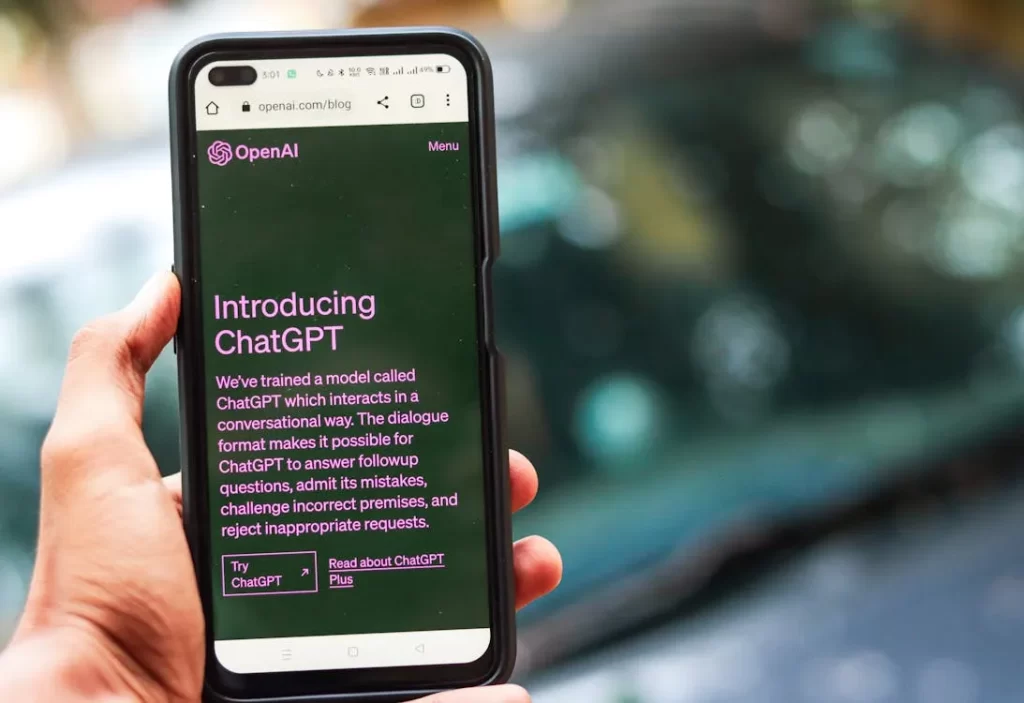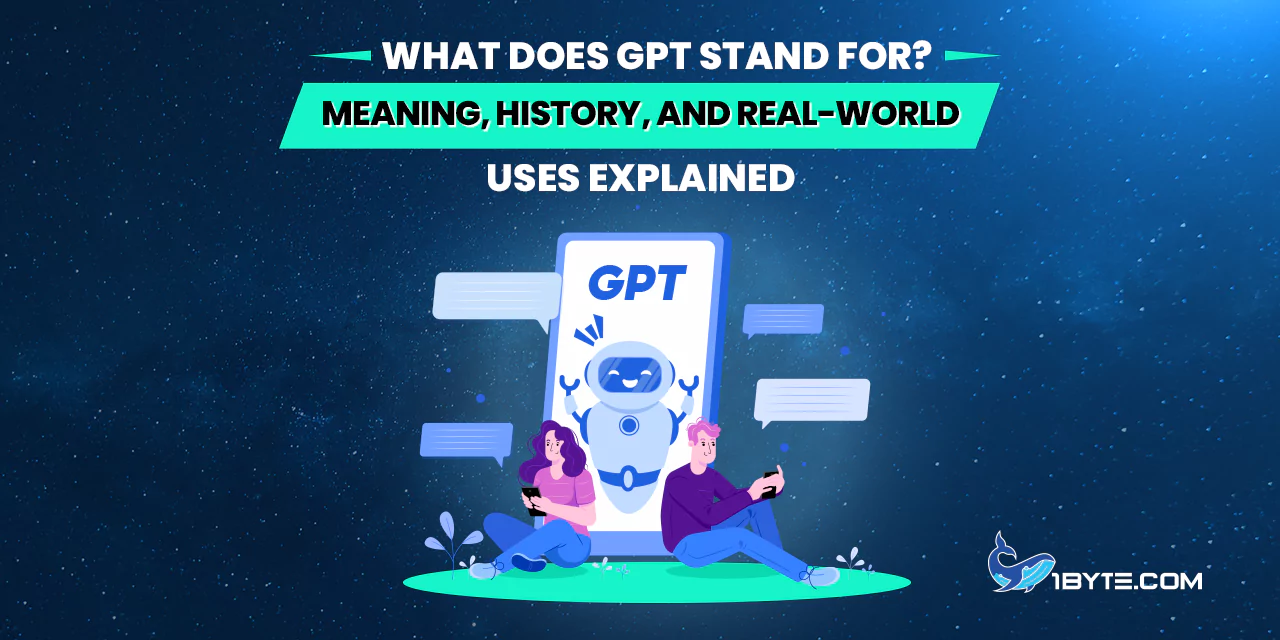What does GPT stand for? In short, GPT stands for “Generative Pre-trained Transformer.” In simple terms, GPT is a type of artificial intelligence model that can generate human-like text based on vast training data. The acronym itself highlights how the technology works: it generates content, is pre-trained on enormous amounts of text beforehand, and uses the Transformer architecture (a neural network design) for understanding language. This concept might sound technical, but it underpins tools many people use today – for example, the “GPT” in ChatGPT refers to this very system. In this article from 1Byte, we’ll break down what each part of GPT means, trace the history of these models from their origin to the latest GPT-4, and explore how GPT technology is used in the real world across industries. Re
Breaking Down the GPT Acronym
In order to have the answer to the question “what does GPT stand for?”, we must break down the terms first. GPT is an acronym that captures the key characteristics of this AI technology. Let’s unpack each term in Generative Pre-trained Transformer:
Generative
The model doesn’t just analyze or categorize language – it generates text. Given a prompt, a GPT model can produce new sentences and paragraphs that look as if a human wrote them. In other words, it’s built to create content (stories, answers, articles, etc.) rather than just outputting canned responses. This generative ability is why GPT models can draft an email, write code, or compose a poem when asked. It’s a fundamental shift from older AI that might only choose from pre-existing answers.
Pre-trained
GPT models undergo extensive training on large collections of text before they ever face specific tasks. They ingest billions of words from books, articles, websites – learning grammar, facts, and even some reasoning abilities from this general corpus. This pre-training means the model starts with a broad understanding of language. Developers can then fine-tune or prompt the same model to perform a particular job (like answering medical questions or writing customer service replies) without training it from scratch for each new task. Pre-training on huge unlabeled datasets is what enabled GPT models to leap ahead of earlier AI, which often required task-specific, labeled data. By first learning from generic text, GPT can be adapted to many applications with relatively little additional training.
Transformer

The term Transformer refers to the neural network architecture used. Introduced by Google researchers in 2017, the Transformer design revolutionized natural language processing by allowing AI to pay “attention” to different words in a sentence more effectively. Unlike older sequence models, Transformers can process words in parallel and learn long-range relationships in text. GPT models are built on this transformer architecture, meaning they can consider the context of each word in a paragraph (or even a whole document) to predict what comes next. This architecture is a big reason for GPT’s fluent and coherent sentences. In short, Transformer technology lets GPT models understand context and nuance in language, making the generated text much more human-like. (For the curious: the breakthrough paper was aptly titled “Attention Is All You Need,” reflecting how this mechanism works.)
Putting it together, a generative pre-trained transformer is an AI system that creates new content, learns from a broad reading of the internet (and more) in advance, and uses an advanced Transformer neural network to understand context. In fact, GPT models are a prominent example of what’s called a large language model or LLM – AI that predicts and generates text based on very large training datasets. Now that we know what GPT stands for, let’s look at how this concept evolved into the powerful models we see today.
From GPT-1 to GPT-4: A Brief History
The journey of GPT began only a few years ago, but progress has been extraordinarily rapid. OpenAI, the research lab behind GPT, introduced the first model in 2018 and has released a series of increasingly powerful versions since then. Each generation grew in size and capability. Here’s a quick timeline of GPT’s evolution:
2018 – GPT-1
The original Generative Pre-Trained Transformer was unveiled by OpenAI in a 2018 research paper. This first GPT model showed that pre-training a transformer on a large chunk of the internet could give it a surprisingly strong grasp of language. GPT-1 was relatively small (around 117 million parameters) compared to its successors, but it proved the core idea: a generative model pre-trained on unlabeled text can be fine-tuned to achieve good results on language tasks. This was a shift from prior NLP models that heavily relied on hand-labeled data – GPT-1’s two-stage training (unsupervised pre-training, then fine-tuning) demonstrated a more efficient way to build language understanding.
2019 – GPT-2

OpenAI followed up with GPT-2 in February 2019, and it was a massive step up. GPT-2 had about 1.5 billion parameters – over 10× larger than GPT-1 – and was trained on a much bigger dataset of about 8 million web pages. With this scale, GPT-2 could generate eerily coherent and fluent paragraphs of text on almost any topic. For example, given a prompt, GPT-2 might continue with several paragraphs of relevant, human-like prose. The improvement was so striking that OpenAI initially did not release the full GPT-2 model to the public out of concern it could be misused to churn out fake news or spam at scale. They opted for a staged release, citing the “malicious purposes” such a powerful text generator might be put to (e.g. generating disinformation). Eventually, the model weights were released as the fears were mitigated, but GPT-2’s debut sparked a serious discussion about AI safety and ethical release strategies.
2020 – GPT-3
If GPT-2 was big, GPT-3 was absolutely gigantic. Released in June 2020, GPT-3 packed 175 billion parameters, two orders of magnitude more than GPT-2. This leap in scale brought a leap in performance. GPT-3 became capable of impressive feats of “few-shot learning” – meaning it could perform tasks it wasn’t explicitly trained for, just by being given a few examples in the prompt. For instance, you could show GPT-3 two examples of translating English to French, then give a new English sentence, and it would produce a reasonable French translation. This ability to infer patterns from prompts without additional training was a milestone. GPT-3’s size and versatility gained worldwide attention; it could write essays, summarize emails, answer trivia, and even generate basic code from natural language. OpenAI offered GPT-3’s capabilities via a cloud API rather than open-sourcing the model, due to its proprietary value and potential risks. Microsoft invested in OpenAI and secured an exclusive license to the GPT-3 model in late 2020. By this time, the term “GPT” was becoming synonymous with cutting-edge AI.
2022 – GPT-3.5 and ChatGPT
After GPT-3, OpenAI worked on refining the model’s ability to follow instructions and hold conversations. They developed fine-tuned versions of GPT-3, often referred to as GPT-3.5. One notable variant, InstructGPT, was trained with human feedback to produce more helpful, accurate responses. These efforts culminated in the release of ChatGPT in late 2022 – a conversational AI based on GPT-3.5 that was fine-tuned to interact through dialogue. ChatGPT was made available to the public (starting as a free research preview), and it exploded in popularity. Within just two months, ChatGPT reached an estimated 100 million monthly users, making it the fastest-growing consumer application in history at that time. This was the moment GPT truly entered the mainstream: people around the world were using an AI chatbot for everyday questions, writing help, tutoring, and more. ChatGPT demonstrated how an LLM like GPT could be packaged into an accessible product. Its success also generated wide awareness of terms like GPT and fueled enormous interest in the next major release.
2023 – GPT-4
OpenAI unveiled GPT-4 in March 2023, marking the fourth generation of the GPT series. GPT-4 is a breakthrough in several ways. Most notably, it is multimodal, meaning it can accept images as inputs in addition to text. For example, you could upload a photo and ask GPT-4 to describe it or answer questions about it – a significant expansion beyond text-only abilities. GPT-4 also exhibits more advanced reasoning and knowledge. On many academic and professional exams it was tested on, GPT-4’s scores reach or exceed the level of the top 10% of human test-takers. (OpenAI reported, for instance, that GPT-4 passed a simulated bar exam with a score around the 90th percentile of test takers, whereas the earlier GPT-3.5 model was around the 10th percentile.) In practical terms, GPT-4 became better at tasks requiring deeper understanding, like solving complex problems or writing more nuanced answers. Another improvement was context length – GPT-4 can handle much longer prompts and conversations. The standard version can process around 8,000 tokens (roughly 6,000-7,000 words) of input, and a special expanded version can handle up to 32,000 tokens (over 20,000 words) at once. This is about 8× the context that GPT-3 could take, enabling GPT-4 to work with very long documents or even analyze lengthy articles in one go. OpenAI also put extensive effort into making GPT-4 safer and more aligned with user intentions, spending months on fine-tuning to reduce harmful or incorrect outputs. GPT-4 was released through a waitlisted API and as part of the paid ChatGPT Plus service, and it quickly became the AI model behind many new applications and integrations in 2023.
2024 – GPT-4 “Turbo” and beyond
The story didn’t stop at the initial GPT-4. OpenAI and others have continued to iterate on the model. In late 2023, OpenAI announced an optimized version called GPT-4 Turbo. GPT-4 Turbo is essentially a souped-up GPT-4 that offers faster responses and lower costs for developers, while maintaining similar capabilities. It also introduced an even larger context window. In fact, GPT-4 Turbo in preview form supports a context of 128,000 tokens – meaning it can ingest and analyze over 300 pages of text in one prompt. This enormous context length opens the door to having the model digest whole books or lengthy transcripts at once. Despite its improvements, GPT-4 Turbo is cheaper to use, with OpenAI reducing prices (about 3× cheaper input, 2× cheaper output compared to the original GPT-4 model) to make AI applications more affordable. OpenAI’s strategy has been to continuously refine these models (GPT-4 Turbo was updated with new knowledge and skills, like a more up-to-date knowledge cutoff in 2023). They even hinted at other variants (for example, an internal version codenamed “GPT-4o” in 2024). While the exact technical details (like the number of parameters in GPT-4) remain undisclosed by OpenAI – there were rumors of 100 trillion parameters which the OpenAI CEO **debunked as an exaggeration – it’s clear that GPT-4 and its successors represent the cutting edge of AI in early 2025. These models are far more capable than the original GPT-1, showing how rapidly AI can advance once scaling and technique prove effective.
With GPT-4’s advanced abilities, the focus has shifted from “can these models generate coherent text?” to “what can we do with them in the real world?” Next, we’ll look at some of the most impactful real-world uses of GPT models across various industries.
Real-World Applications of GPT Technology
Generative Pre-trained Transformers are not just research curiosities—they are actively transforming how work is done in many fields. From assisting doctors in analyzing medical information to helping customer support agents reply faster, GPT models are being applied wherever language is involved. Below we explore a few key industries (healthcare, finance, education, and customer service) to help you understand the question “what does GPT stand for?” better, as well as how GPT-powered systems are making a difference in each.
Healthcare: AI Aiding Doctors and Patients
In healthcare, GPT models are used as intelligent assistants to support both clinicians and patients. One major application is in medical diagnosis and decision support. Researchers have tested GPT-4 on challenging medical exam questions and case studies. The results are promising – in one study published in the New England Journal of Medicine, GPT-4 correctly diagnosed about 52.7% of complex cases, outperforming the 36% success rate of human doctors reviewing the same cases. This suggests GPT-4 can serve as an effective second opinion for physicians, catching details that busy doctors might miss. Another experiment, published in Nature Medicine, found that physicians who used GPT-4’s assistance made better clinical decisions in complex cases and spent more time considering holistic patient factors. In practice, a doctor could input a patient’s symptoms or lab results and ask the GPT-based assistant for possible diagnoses or treatment suggestions. The model can sift through its learned medical knowledge to highlight relevant insights (though a human doctor must still confirm and validate the suggestions).
Besides diagnosis, GPT models help in medical documentation and patient communication. They can draft clinical notes, summarize patient histories, or even generate easy-to-understand explanations of medical conditions for patients. Hospitals are exploring using GPT-powered tools to transcribe and organize doctor-patient conversations, reducing the paperwork burden on doctors. There are also mental health apps using GPT-driven chatbots to provide wellness coaching or preliminary counseling to patients, making basic support more accessible (with the important caveat that AI is not a replacement for professional care). Overall, GPT’s strength in language understanding and generation can free up clinicians’ time by handling routine writing tasks and provide them with data-driven insights, all while patients might get quicker answers to their questions. The use of GPT in healthcare is still emerging, but early results show it augmenting medical professionals – helping catch errors, suggest treatments, and educate patients – which could lead to safer and more efficient care when used responsibly.
Finance: Analyzing Data and Assisting in Decision-Making
The finance industry deals with huge volumes of information daily, from market reports to customer inquiries. GPT models have found a natural home here as well, where they assist with research, customer service, and internal knowledge management. A great example is at Morgan Stanley, a leading global financial services firm. Morgan Stanley has integrated GPT-4 into its wealth management division to help financial advisors query the company’s vast knowledge base. Advisors can ask the AI assistant complex questions (for instance, details about a particular investment product or the firm’s strategy on sustainable investing), and the GPT-4 system will retrieve and summarize information from tens of thousands of internal documents. This AI tool was so useful that over 98% of Morgan Stanley’s advisor teams adopted it for daily use. By embedding GPT-4 in their workflow, advisors dramatically cut down the time spent searching for information – the system can effectively answer questions from a corpus of 100,000+ documents nearly instantly. In the past, an advisor might have spent valuable time combing through research PDFs or corporate policy manuals; now they can get concise answers in seconds, which means faster service for their clients and more informed advice.
Beyond internal use, banks and fintech companies are using GPT-powered chatbots to handle customer inquiries. For example, a banking chatbot backed by a GPT model can understand a customer’s written question (“How do I increase my credit card limit?”) and provide a clear, helpful answer, possibly even executing tasks like guiding them through the steps – all in natural language. This improves customer service availability (24/7 instant support) and relieves call center volumes for more complex issues. GPT models can also assist in financial analysis: summarizing earnings reports, drafting market commentary, or even scanning news to flag risks and opportunities. While human analysts and advisors remain critical, GPT can take over a lot of the heavy reading and initial drafting. It’s worth noting that firms are cautious with AI in finance due to accuracy and compliance – answers must be correct and adhere to regulations. That’s why efforts like Morgan Stanley’s involve rigorous evaluation and fine-tuning of the model’s outputs. When done carefully, GPT becomes a powerful tool to digest data and support decision-making in finance, whether it’s an investment analyst getting a quick summary of a 100-page report or a customer getting instant answers about their account.
Education: Personalized Learning and Tutoring

Education is another field being transformed by GPT technology. The ability of GPT models to understand questions and explain concepts makes them well-suited as tutors and teaching assistants. One high-profile example is Khan Academy’s AI tutor, Khanmigo. Khan Academy – a popular online education nonprofit – introduced Khanmigo as a pilot program powered by GPT-4. Students can use it to get help with math problems, practice writing, or explore questions in various subjects through a chat interface. Unlike a typical search engine, a GPT-4 tutor can ask the student questions back, guide them step-by-step to the solution, or adjust its explanation if the student is confused. It’s like having a patient, always-available tutor that can personalize the teaching to each learner. Early results are encouraging: Khan Academy’s team reports that GPT-4 is opening up “new frontiers in education” and could significantly help in one-on-one tutoring and feedback. Teachers can also benefit – the AI can act as an assistant that helps draft lesson plans, create quiz questions, or give feedback on student writing, saving educators time on routine tasks.
Language learning apps are also using GPT to enhance education. Duolingo, for instance, integrated GPT-4 into a premium offering called Duolingo Max. This allows language learners to engage in AI-driven role-play conversations (practicing real-world dialogues like ordering coffee in French) and get instant AI feedback on their responses. The model can correct mistakes and explain the rules, functioning almost like a personal language coach. Such interactivity was hard to achieve before GPT-level AI. Additionally, GPT models can help make education more accessible – they can simplify complex text for a younger reading level, translate content, or answer follow-up questions at any time. Students in remote areas or with limited access to teachers could potentially learn from a GPT-based tutor whenever they want. That said, educators are proceeding carefully: they must ensure the AI’s answers are accurate and that students still learn critical thinking (rather than just accepting whatever the AI says). There’s also the challenge of preventing misuse (like having AI do all of a student’s homework). But used correctly, GPT in education offers a highly customized learning experience – something traditionally difficult to achieve in a one-to-many classroom setting.
Customer Service: Faster, Smarter Support Chats
If you’ve chatted with an online customer support agent recently, there’s a good chance an AI was working behind the scenes – and possibly a GPT model at that. Customer service is being revolutionized by GPT-driven conversational agents that can understand queries and generate helpful responses. Companies are deploying these AI agents on websites, messaging apps, and call centers to handle common customer requests. For example, Salesforce (a major CRM platform) introduced Einstein GPT, which uses OpenAI’s technology to assist customer support teams. It can auto-generate personalized replies to customer emails or chat messages, helping human agents resolve issues more quickly. If a customer asks, “I need to return an item, what’s the process?”, a GPT-powered system can instantly draft a courteous, accurate response with the return instructions, pulling details from the company’s return policy database. The human agent just reviews and sends it, saving time. This leads to quicker response times and often higher customer satisfaction, since the customer isn’t waiting long for an answer.
GPT models also excel at understanding the tone and context of a conversation, allowing for more empathetic and natural interactions. They can be instructed to adopt a friendly, professional style that matches a company’s brand voice. Over time, as the AI is trained on more customer interactions, it gets better at handling diverse questions – from troubleshooting technical issues (“Why won’t my device connect to Wi-Fi?”) to guiding a purchase (“Which plan is best for my needs?”). An advantage of GPT-based support bots is that they can handle multiple languages and operate 24/7, scaling up during peak inquiry times without hiring additional staff. Some businesses report significant reductions in handling time; for instance, generative AI help can cut down a task that used to take 15 minutes into just seconds, and increase productivity by 20% or more in customer operations. Human agents are then free to focus on more complex or sensitive cases that truly require a person’s touch.
Of course, companies must monitor AI outputs to avoid mistakes (like an AI confidently giving a wrong answer). Many deploy GPT models in an assistive role, where the AI suggests replies and a human approves them. This “human in the loop” approach combines speed with oversight. Going forward, we can expect customer service to increasingly use GPT models as front-line responders for initial queries and routine requests. The result is a faster, smarter customer support experience – one where issues are resolved efficiently, and customers feel heard and helped, whether they’re chatting with a human or an AI that sounds surprisingly human.
Leverage 1Byte’s strong cloud computing expertise to boost your business in a big way
1Byte provides complete domain registration services that include dedicated support staff, educated customer care, reasonable costs, as well as a domain price search tool.
Elevate your online security with 1Byte's SSL Service. Unparalleled protection, seamless integration, and peace of mind for your digital journey.
No matter the cloud server package you pick, you can rely on 1Byte for dependability, privacy, security, and a stress-free experience that is essential for successful businesses.
Choosing us as your shared hosting provider allows you to get excellent value for your money while enjoying the same level of quality and functionality as more expensive options.
Through highly flexible programs, 1Byte's cutting-edge cloud hosting gives great solutions to small and medium-sized businesses faster, more securely, and at reduced costs.
Stay ahead of the competition with 1Byte's innovative WordPress hosting services. Our feature-rich plans and unmatched reliability ensure your website stands out and delivers an unforgettable user experience.
As an official AWS Partner, one of our primary responsibilities is to assist businesses in modernizing their operations and make the most of their journeys to the cloud with AWS.
Conclusion
So, what does GPT stand for? In summary, GPT stands for Generative Pre-trained Transformer, and it has grown from a novel research idea into a cornerstone of modern AI. In just a few years, the GPT series (GPT-1, 2, 3, 4, and variants) has pushed the boundaries of what machines can do with language. These models have learned to write essays, debug code, pass exams, and hold conversations that feel natural. Equally important, they’ve moved from the lab into the real world, where they’re boosting productivity and unlocking new solutions across industries. Whether it’s a doctor getting AI help in diagnosing a patient, a student learning algebra with a virtual tutor, or a customer receiving instant support in an online chat, GPT is often the unseen engine powering the experience.
The history and use cases we explored show both the power and responsibility that come with this technology. GPT models offer incredible benefits – speed, scale, and intelligence in processing language – but they also require careful deployment to ensure accuracy, fairness, and safety. OpenAI and other organizations are continually refining these models (for example, with GPT-4 Turbo and ongoing updates) to be more reliable and aligned with human needs. It’s likely that even more advanced successors are on the horizon (GPT-5 and beyond), which could further enhance capabilities like understanding visuals, handling even larger contexts, or exhibiting more common sense reasoning.

